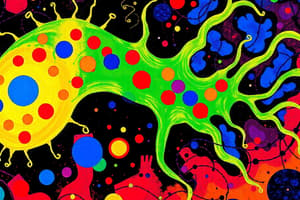Podcast
Questions and Answers
What is the primary method of transmission of Plasmodium sp.?
What is the primary method of transmission of Plasmodium sp.?
- Through contaminated food and water
- Through the feces of an infected cat
- By the bite of an infected female Anopheles mosquito (correct)
- Through direct contact with an infected person
What is the disease caused by Toxoplasma gondii?
What is the disease caused by Toxoplasma gondii?
- Malaria
- Trypanosomiasis
- Toxoplasmosis (correct)
- Amoebiasis
What is the characteristic of the ulcer caused by Entamoeba histolytica?
What is the characteristic of the ulcer caused by Entamoeba histolytica?
- Irregular shape
- Round shape
- Oval shape
- Flask shape (correct)
What is a common complication of Entamoeba histolytica infection?
What is a common complication of Entamoeba histolytica infection?
What is the primary mode of transmission of Toxoplasma gondii?
What is the primary mode of transmission of Toxoplasma gondii?
What is the reproductive stage of Plasmodium sp.?
What is the reproductive stage of Plasmodium sp.?
What is the characteristic of the liver abscess caused by Entamoeba histolytica?
What is the characteristic of the liver abscess caused by Entamoeba histolytica?
Which of the following protozoan parasites moves by the action of flagella?
Which of the following protozoan parasites moves by the action of flagella?
What is the primary reservoir of Entamoeba histolytica?
What is the primary reservoir of Entamoeba histolytica?
What is the mode of locomotion of Entamoeba histolytica?
What is the mode of locomotion of Entamoeba histolytica?
Which of the following is NOT a characteristic of Sporozoa?
Which of the following is NOT a characteristic of Sporozoa?
Which vector is responsible for transmitting malaria?
Which vector is responsible for transmitting malaria?
What is the mode of transmission of Trypanosomiasis?
What is the mode of transmission of Trypanosomiasis?
What is the disease caused by Entamoeba histolytica?
What is the disease caused by Entamoeba histolytica?
What is the characteristic feature of helminths?
What is the characteristic feature of helminths?
Which of the following is a characteristic of protozoan parasites?
Which of the following is a characteristic of protozoan parasites?
What is the common symptom of Trypanosomiasis in immunocompromised individuals?
What is the common symptom of Trypanosomiasis in immunocompromised individuals?
What is the intermediate host of Echinococcus?
What is the intermediate host of Echinococcus?
What is the habitat of Taenia saginata?
What is the habitat of Taenia saginata?
What is the morphology of the adult Taenia saginata?
What is the morphology of the adult Taenia saginata?
How do cows get infected with Taenia saginata?
How do cows get infected with Taenia saginata?
Which of the following characteristics is NOT true about protozoa?
Which of the following characteristics is NOT true about protozoa?
What is the term for a permanent association between two organisms?
What is the term for a permanent association between two organisms?
Which type of host is essential to parasite survival and a focus for spread to other hosts?
Which type of host is essential to parasite survival and a focus for spread to other hosts?
Which of the following is a characteristic of the life cycle of protozoa?
Which of the following is a characteristic of the life cycle of protozoa?
Which of the following helminths is classified as a Cestode?
Which of the following helminths is classified as a Cestode?
What is the primary method of transmission for malaria?
What is the primary method of transmission for malaria?
Which of the following is a symptom of trypanosomiasis?
Which of the following is a symptom of trypanosomiasis?
Which of the following protozoa is associated with toxoplasmosis?
Which of the following protozoa is associated with toxoplasmosis?
Which type of host is responsible for the sexual cycle of a parasite?
Which type of host is responsible for the sexual cycle of a parasite?
Flashcards are hidden until you start studying
Study Notes
Entamoeba Histolytica
- Causes amoebiasis
- Mode of locomotion: pseudopodia
- Geographical distribution: cosmopolitan, more common in tropical and subtropical countries with poor sanitation
- Habitat: lumen of large intestine, can invade wall of intestine
- Reservoir: humans, dogs, pigs, monkeys
- Morphology: two forms - cyst and trophozoite
- Infective stage: cyst in polluted water and infected food
- Pathogenic stage: trophozoite in large intestine, causes ulcer and liver damage
- Clinical symptoms: asymptomatic in normal hosts, severe in immunocompromised individuals, congenital infections can cause blindness in newborns
Toxoplasma Gondii
- Causes toxoplasmosis
- Transmission: eating undercooked meat, contaminated food and water, congenital transmission, person-to-person
- Geographical distribution: worldwide
- Clinical symptoms: fever, severe abdominal pain, liver damage
- Complications: liver abscess, lung, skin, and brain damage
Plasmodium Sp. (Malaria)
- Transmission: female Anopheles mosquito
- Life cycle: sexual reproduction in mosquito, asexual reproduction in human
- Clinical symptoms: dysentery, blood and mucous diarrhea, severe abdominal pain
- Complications: peritonitis, appendicitis, hemorrhage, liver damage
Protozoa
- Unicellular, eukaryotic organisms
- Inhabit water and soil
- Life cycle: trophozoite and cyst
- Reproduction: asexual by fission, budding, or schizogony
- Some are part of normal microbiota, others cause human disease
Classification of Parasites
- Protozoa: single-celled eukaryotes, blood and tissue, intestinal, urogenital tract
- Helminthes: multicellular eukaryotes, platyhelminthes (flatworms), nematoda (roundworms), cestodes (tapeworms)
Helminthes
- Multicellular eukaryotic animals
- Possess digestive, circulatory, nervous, excretory, and reproductive systems
- Types: platyhelminthes (flatworms), nematoda (roundworms), cestodes (tapeworms)
- Examples: Taenia saginata (beef tapeworm), Taenia solium (pork tapeworm), Diphyllobothrium (broad fish tapeworm), Echinococcus (dog tapeworm)
Taenia Saginata (Beef Tapeworm)
- Habitat: small intestine, ileum
- Transmission: ingestion of raw or poorly cooked meat of infected cows
- Morphology: adult divided into three parts - head, neck, segments
- Clinical symptoms: asymptomatic, rare cases of intestinal obstruction
Studying That Suits You
Use AI to generate personalized quizzes and flashcards to suit your learning preferences.




